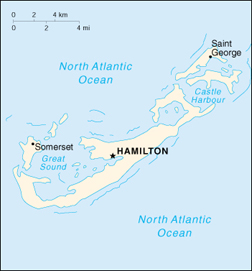

|


|
 |
 |
 |
 |
 |
 |
 |
 |



 Bermuda 
Bermuda has the most divable shipwrecks in the Western Hemisphere. That’s why Skin Diver Magazine named Bermuda the “Shipwreck Capital of the Atlantic”—you’ll find more than five centuries of nautical history waiting for you beneath Bermuda’s waters. Crystal-clear waters make Bermuda one of the most breathtaking dive destinations in the world. On the northern and western reefs, the visibility in the summer is about 100 feet. Where the reef line comes much closer to the shore, on the southern and eastern reefs, summer visibility averages 80 feet. Dive shops display a map of the outlaying reef system and 38 wrecks. But depending on your skill level, you can dive over 350 wrecks dating back to the 15th century. A popular site is the 200-foot schooner the Constellation, Peter Benchley’s inspiration for The Deep. At some sites, shipwrecks are so close to one another, you can explore multiple ships in the same dive. The Shipwreck Certificate Program was created to introduce divers to 18 special shipwrecks. These wrecks are selected for their history, photogenic qualities, swim-throughs, etc. And after diving any one of these 18 wrecks, you’ll receive a Bermuda Shipwreck Certificate which names the shipwreck, provides a brief history of the wreck, and includes a silhouette of the ship prior to its sinking. Grab your mask, fins, and snorkel. Fill up your tank. Then chart a course for more than five centuries of nautical history waiting for you beneath Bermuda’s waters. Just click on your interest below, and don’t forget to come up for air when it’s time to book your vacation. The season starts about mid-March and runs through November, although some operators dive year-round. On Bermuda’s northern and western reefs, the visibility in the summer is about 100 feet. Where the reef line comes much closer to the shore, on the southern and eastern reefs, summer visibility averages 80 feet. The Gulf Stream undulates to the north and west minimising weather extremes, crediting Bermuda with its subtropical status. The water temperature in the height of summer (July–September) is in the mid-80s, and a 1/8" shorty is sufficient. During the season’s peripheral months, April, May, and most of June, October, and November, a 1/4" wetsuit is recommended. Air temperature rarely gets above 90 degrees in the summer, or below 60 degrees in the winter. Shipwrecks Blanch King American schooner built in 1887. En route in 1920 from Norfolk with a load of coal, she became stranded on the reefs and sank. Lying near the North Carolina, her cable and rigging are scattered across the reefs. Caraquet 350' mail packet and passenger steamer, launched in 1894. In 1923, while en route from St. John to Halifax, she wrecked on Bermuda’s Northern Barrier Reef. All passengers, crew, and mail were landed safely. She lies 30' down. Constellation 200' American schooner built in 1918. In 1943, this ship was carrying building materials, medicinal drugs, and 700 cases of scotch whiskey to Venezuela when she went down. She lies in 30' of water. Cristobal Colon 500' Spanish luxury liner launched in 1923. The largest of Bermudian wrecks, she lies 30'–55' under with her wreckage scattered across 100,000 square feet. She offers hours of fascinating exploration. Darlington A steamer built in 1881. While on a voyage from New Orleans to Germany in 1886, she hit a reef and sank. She lies 20' down, and within swimming distance of an unidentified Spanish galleon. Hermes A 165' steel buoy tender built during World War II, and our most popular wreck dive. In 1985, she became an artificial reef and rests 80' down with her mast pointing toward the surface. She is fully intact. Iristo (Aristo) 250' Norwegian freighter that wrecked in 1937 while trying to avoid the wreck of the Cristobal Colon. She lies 50' down with her bow 18' from the surface. Lartington Early steam freighter wracked by storms while en route from Georgia to Russia in 1879. She was already floundering badly when she hit a reef and sank. She lies in 15'–35' of water. L'Herminie First-class, 60-gun French frigate. In 1838, while returning to France from a skirmish in Mexico, she crashed into a reef. She lies in 20'–30' of water off the western side of the island, with 25 cannons still visible. Madiana A passenger/light cargo ship built in 1877. In 1903, while en route to the West Indies with passengers and cargo, she struck a reef and sank. She sits 25' down, one mile from the Caraquet. Mary Celestia 225' English paddlewheel steamer from the American Civil War. Chartered to the Confederacy for blockade running, she sank in 1864. The wreck lies in 55' of water with one of her paddlewheel frames standing upright. Minnie Breslauer A 300' English steamer on her maiden voyage when she sank in 1873. She lies one mile from shore, in depths from 35'–70'. Montana (Nola) A 236' paddlewheel steamer. Coral reefs accomplished what no Union gun boat could do, and this elusive Civil War blockade runner sank in 1863. She’s now adorned with lovely coral. North Carolina A 205' English barque that struck a reef and sank on New Year’s Day 1880. She sits upright in depths of 25'–40'. The curves of her fantail stern have a touch of ghostly grace. Pelinaion A 385' cargo steamer built in 1907. The best East End wreck. While heading to Baltimore, she struck a reef off St. David’s Head in 1940. Lying one mile offshore 20'–70' down, she is a massively large and awesome sight. Pollockshields A cargo steamer built in 1890, it ran into a “white squall” in 1915. She can be found scattered in 20'–40' of water on a coral bottom. Live ammunition, shell casings, boilers, a propeller, and her engine can be seen amongst her wreckage. Taunton 228' Danish cargo steamer built in 1902. Another victim of Bermuda’s tricky reefs, she sank in 1920. The Taunton is a favourite shallow water dive and quite a photogenic wreck, as her bow comes within 10' of the surface. Xing Da A target of a US Immigration sting operation, the Xing Da was captured and towed to Bermuda in 1997. She was sunk in 106' of water, and she landed upright in a sand hole. She is so large, it takes several dives to see all of her. |





|